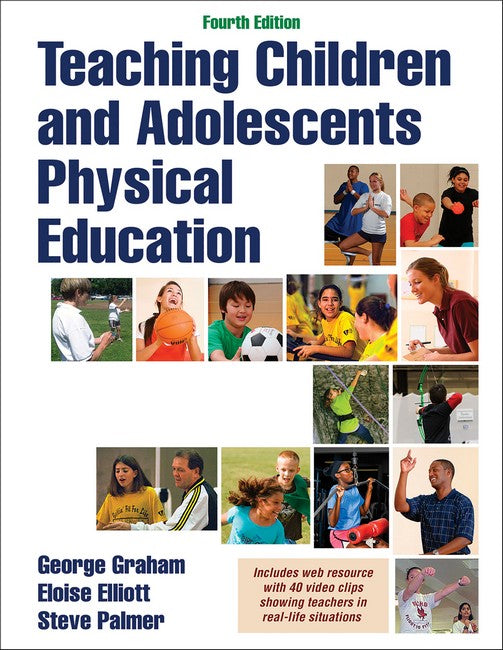George Graham, PhD, is an award-winning university professor and public school physical education instructor who was named to the NASPE Hall of Fame in 2007. He is the author of Children Moving, currently in its ninth edition and used in more than 250 universities throughout the United States. Graham has spoken on the topic of positive physical education on CBS This Morning, CNN, and National Public Radio. He also has been cited in USA Today, the Harvard Review, and the Washington Post. Eloise Elliott, PhD, is a Ware Distinguished Professor at West Virginia University, where she leads initiatives to improve the physical activity participation of children. She has developed and taught university physical education teaching courses and conducted teacher training. She developed and oversees a web-based resource to help teachers include physical activity in the pre-K-8 classroom. A former public school physical education teacher, Elliott was appointed to the national President's Council on Fitness, Sports and Nutrition Science Board. Steve Palmer, PhD, is associate dean at Northern Arizona University (NAU) in Flagstaff. His background includes 15 years in physical education teacher education and research. He also has taught elementary and middle school physical education. Palmer leads and coordinates NAU's physical education teacher education program. He has published numerous papers related to physical education curriculum and teaching.
Request Academic Copy
Please copy the ISBN for submitting review copy form
Description
Chapter 1. Successful Teaching * The Teacher, Not Only the Content * How Teaching Physical Education Differs From Teaching in the Classroom * Analogies of Teaching * Changing and Dynamic Nature of Teaching * Difficulty of Describing Good Teaching * Challenge of Teaching Physical Education * The Teacher Makes the Difference * Pedagogy Toolbox * Working Definition of Successful * Summary Chapter 2. Creating a Positive Learning Environment * Teacher Expectancy * Teacher Stereotypes * Creating an Emotionally Safe Environment * Determining Management Protocols * Teaching Behavior Protocols * Summary Chapter 3. Long-Term Planning * Need for Planning * Tendencies to Avoid Planning * Planning Formats and Components * Summary Chapter 4. Writing the Lesson Plan * Writing the Daily Lesson Plan * Lesson Purpose: Learnable Pieces * Developing the Content * Major Parts of a Lesson Plan * Lesson Components * Adapting Lessons for Students With Special Needs * Summary Chapter 5. Teaching From the Lesson Plan * Student Centered Versus Subject Centered * Observation Techniques * Four Key Content Development Questions * Observing Individuals * Observing Classes for Content Development * Fun * Summary Chapter 6. Getting the Lesson Started * Instant Activity * Communicating the Purpose of the Lesson * Traditional Ways to Start a Lesson * Summary Chapter 7. Instructing and Demonstrating * Instructing * Demonstrating * Pinpointing * Checking for Understanding * Play-Teach-Play * Using Video Technology * Analyzing Students' Use of Time * Summary Chapter 8. Motivating Students to Practice * Three Keys to Motivating Youngsters * Eight Techniques for Motivating Students * Developing Realistic Expectations * Teacher as Cheerleader * Summary Chapter 9. Providing Feedback * Types of Feedback * Analyzing Your Feedback * Research on Physical Education Teacher Feedback * Summary Chapter 10. Minimizing Off-Task Behavior and Discipline Problems * Why Do Students Act Out? * Strategies for Minimizing Off-Task Behavior * Discipline Systems * Characteristics of Effective Discipline Systems * Disciplinary Confrontation * Summary Chapter 11. Building Critical Thinking Skills * Value of Critical Thinking Experiences * Convergent Problem Solving * Divergent Problem Solving * Verbal Problem Solving * Necessary Teacher Characteristics * Direct or Indirect Approach: Which Is Best? * Summary Chapter 12. Building Positive Feelings * Inappropriate Practices * Intentional and Ever Present * Techniques and Strategies * Testing * Understanding Feelings * Learned Helplessness * Concluding Thoughts * Summary Chapter 13. Assessing and Reporting Student Progress * Why Assess? * What to Assess? * Alternative Assessment * Evaluating Assessment Data * Standardized Assessments * Reporting and Grading * Summary Chapter 14. Continuing to Develop as a Teacher * Stages of Teaching * Techniques for Continuing to Improve as a Teacher * Seven Habits of Highly Effective Teachers * What Type of Teacher Will You Become? * Parting Thoughts * Summary

